Final report for OS14-088
Project Information
Summary: Forage-based year-round grazing is feasible in Alabama and Southeastern USA through utilization of cool- and warm-season forages. This can be achieved by allowing for as much grazing as possible throughout the year. A series of experiments were conducted at the Caprine Research and Education Unit in George Washigton Carver Agricultural Experiment Station in Tuskegee University to develop and demonstrate a profitable and sustainable year-round forage based production system with sunn hemp (SH), Bermudagrass (BG), and SH+BG combined systems in the summer-fall followed by a winter wheat forage system for the Southeastern U.S. during the last 1 year. The results indicated that animals on SH and SH + BG combinations grew significantly faster and reached expected slaughter weight in less time when compared to BG pasture systems. The SH in the summer and fall followed by winter wheat grazing systems were the most productive with regards to biomass production. This is probably due to higher nutritive values of SH forage diets throughout the year. Soil and forage nutrient contents, and economic benefits will be reported in the future. Raising goats on SH was the least expensive system in terms of inputs required and seems profitable.
- To determine pasture quality and soil fertility changes combining summer legume forage such as sunn hemp followed by winter forage;
- To determine animal health and performance of goats when sunn hemp is incorporated in the feeding system and when grazing multi-culture grasses, and grasses in combination with legumes;
- To determine soil quality changes using multi-culture grasses, and grasses in combination with legume forages;
- To identify and assess economic characteristics and optimum economic return of different goat production (grasses/legumes) systems;
- To evaluate adaptability (on an experiment station with goats) and demonstrate applicability (on two small farms) of an integrated year round forage system using commercial goats.
Cooperators
Research
Experimental treatments included:
Summer forage system
- Control (Bermudagrass; BG)
- Treatment 1 (Sunn hemp; SH)
- Treatment 2 (BG + SH; 70:30 %, respectively)
Winter forage system
- Winter wheat grass (WG) plant on BG paddock
- WG plant on treatment 1 (SH)
- WG plant on treatment 2 (BG+SH)
Data Collection
Forage mass (kg DM/ha), botanical composition and forage chemical composition were measured from February to May for winter forages and May to September for summer forages in 2015 and 2016 (Figures 1 and 6). On each occasion four random quadrates (0.25 m2) per paddock were cut using a hand-clipper for biomass. The forage samples were then oven-dried at 90 oC for 18 h, and weighed. For laboratory analysis, four quadrates of herbage on offer were cut to ground level from each paddock. Samples were combined for each paddock, mixed, and divided, with the first part used for botanical composition assessments and the second part for chemical analysis.
Statistical analysis
All data were analyzed as repeated measure with production system included in the model as a fixed effect using the Proc GLM procedure of SAS (SAS Inst. Inc., Carry, NC). Differences among means, for all analysis, were determined by least square means procedure with the protected F-test (P < 0.05).
Abbreviations:
ADF: acid detergent fiber; ADG: average daily gain; A/P ratio: acetate/propionate ratio; BW: body weight; BG: bermudagrass; CP, crude protein, DR: dry matter; FEC: fecal egg counts; NDF: neutral detergent fiber; NFC: non-fiber carbohydrate; SH: sunn hemp; TDN, total digestible nutrients; VFA: volatile fatty acids.
I. Summary
A year-round grazing is feasible in Alabama and Southern USA through utilization of cool- and warm-season forages. This can be achieved by allowing for as much grazing as possible throughout the year. Producers should select a combination of forages with different growth cycles that will best support the objectives of their operation. A series of experiments were conducted at the Caprine Research and Education Unit in George Washington Carver Agricultural Experiment Station in Tuskegee University (Table 1; Figures 1 and 2) to develop and demonstrate a profitable and sustainable year-round forage based production system with sunn hemp (SH), bermudagrass (BG), or SH+BG system in summer grazing followed by winter wheat forage system for the Southeastern U.S. during the last 2 years. The results indicated that animals on SH or SH+BG combination grew 62 to 67% faster and reached expected slaughter weight in less time when compared to conventional BG pasture systems. The legume forage SH and SH+BG in the summer followed by winter wheat forage systems were the most productive with regards to biomass production and animal weight gain. This is probably due to higher nutritive values of forage diets throughout the year (Table 1). The soils contained significantly higher percent of Ca in the SH and SH+BG systems compared to BG treatments. Raising goats on SH was the least expensive system in terms of inputs required and seems profitable. The SH + BG system were also comparatively better than the traditional pasture system. The sole BG pasture system was found to be the least sustainable because of the need for higher amounts of fertilizer, supplemental feeds, and anthelmintics. We feel that using proper legume forages for the summer legume forage followed by winter forages can provide for profitable year-round foraging system for producers. However, combination of forages used for grazing should be selected to optimize animal performance, enhance soil property and reduce environmental impacts from animals while reducing dependency on petrochemical fertilizers. We believe that the SH alone or SH+BG combination will increase protein outputs as well as restore N in soil, thus reducing dependency on petroleum-based fertilizers.
II. Accomplishments/Milestones
Objective 1. To determine pasture quality and soil fertility changes combining summer legume forage such as sunn hemp (SH) followed by winter forage.
For this objective, three forage combinations (grass vs. legume), for summer gazing followed by winter forages were planted in duplicates on 6 pasture paddocks of 0.5 acres each during 2015 and 2016, and had been successfully completed without any fertilizer application (Figure 1). Grazing experiment for summer forage in year 2016 had been difficult to conduct because of severe drought (Figure 1 b, d). However, new forage legume SH (Crotalaria juncea L) grows generally well during drought in 2016.
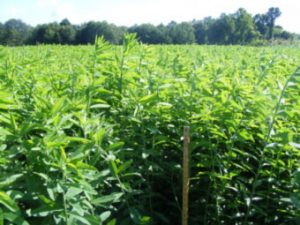
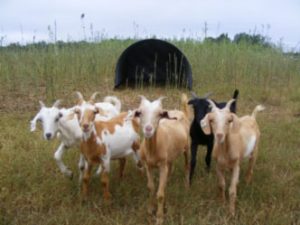
(a) SH with good rainfall (b) SH with drought
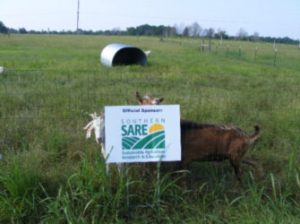
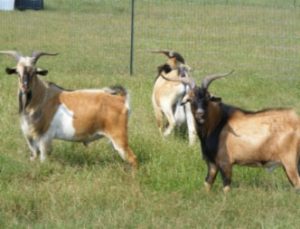
(c) BG with good rainfall (d) BG with drought
Figure 1. Sunn hemp (SH;a, b) and bermudagrass (BG; c, d) forages in year 1 and 2, respectively.
Forage biomass production
The benefit of using multiple species on the same pasture comes from the fact that different animals have different plant preferences. Forage dry matter production is presented in Figure 2 and Table 1. Multi-culture forage dry matter (DM) production from May to September during 2 years was higher (P < 0.05) for BG + SH combination than BG or SH forage alone in year 1 and year 2, respectively. In addition, forage DM production in BG was significantly lower (P < 0.01) than SH forages, but there were forages by year interactions (P < 0.05), suggesting that high precipitation rate in year 1 provided more forage biomass production among treatments compared to year 2 in drought year.
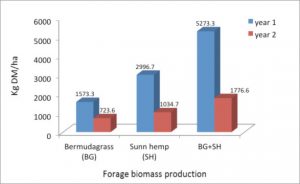
Figure 2. Summer forage biomass production (Kg DM/ha) with bermudagrass (BG) and sunn hemp (SH) forages with BG + SH combinations during 2 years in 2015 and 2016.
Forage chemical composition
Summer forage chemical composition of multi-cultural forage system is presented in Figure 3. There was a forage chemical composition x year interaction (P < 0.05; not shown in the text) for CP and ADF, indicating that CP and forage ADF composition may be effected by year (e.g. precipitation and drought). Average CP content in SH and SH+BG mixed forages were higher (P < 0.05) than BG forage, but lower in ADF content in SH+BG combination. There were no different in DM and TDN contents among treatments.
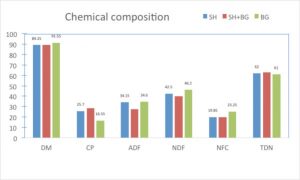
Figure 3. Average forage dry matter (DM), crude protein (CP), acid detergent fiber (ADF), neutral detergent fiber (NDF), non-fiber carbohydrate (NFC), and total digestible nutrient (TDN) compositions in multi-forage system in Tuskegee University in Alabama during 2 years.
Objective 2. To determine animal health and performance of goats when sunn hemp is incorporated in the feeding system and when grazing multi-culture grasses, and grasses in combination with legumes.
This objective was fully investigated by 2015 and 2016. Goats were placed in each of the two 1½ acre plots (n = 6 and 2 replicates; Figure 1) and it is one of the main contributions of this report. Thirty-six cross breed goats were placed on 6 paddocks, 6 goats each (the two ½ acre plots of each forage combination replicated twice) and spent approximately 58 days in each plot during 2 years. Initial body weight (BW) were not different, but final BW (P < 0.05) and average daily gain (ADG) was higher (P < 0.01) for goats grazing on SH or SH + BG forages and was lowest ADG for goats on BG forage (Table 1 and Figure 4).
Goats fed SH (Figure 5) increased molar proportion of acetate (P < 0.05) and propionate production, while goats received SH forage diet reduced proportions of acetate/propionate ratio (A/P; P < 0.05) compared to those in control (BG) and SH+BG forage. Goats grazing on grass diets decreased volatile fatty acids (VFA) production compared to legume forage or legume + grass mixed forage diets.
Furthermore, for summer legume forages followed by winter wheat forage, animal performance and ADG without fertilization are presented in Table 1. Legume forage effect was conducted to test carry-over effect: combining legume forage SH for the summer grazing followed by winter forages (winter wheat) was improve winter forage biomass production, animal performance, soil fertility, and profitable year-round grazing system (Figure 6). Average biomass production in winter wheat forage was higher (P < 0.05) for SH-planted soil than for BG-planted soil. In addition, ADG was higher (P < 0.05) for goats grazing on SH-planted winter wheat forage than for goats on BG-planted winter wheat forage. It can be suggested that combining such as SH and multi-forages with legumes may increase protein output (Table 1) and improve rumen fermentation (Figure 5) as well as improve biomass production without fertilizer application, thus reducing dependency on petroleum-based fertilizers.
Table 1.The average biomass production (kg DM/ha), animal body weight (BW) growth, and average daily gain (ADG) in multi-forage system grazing in goats during 2 years.
_____________________________________________________________________________________
Item N1 Forage biomass Initial BW Final BW ADG (g/d)
_____________________________________________________________________________________
Summer forage system (58 days)
Bermudagrass (BG) 6 1148.5 28.2 31.0 48.9
BG + Sunn hemp (SH) 6 3524.8 25.6 28.4 129.1
Sunn hemp (SH) 6 2015.4 27.1 35.5 148.7
Winter wheat forage (45 days)
BG 4 220 24.7 33.6 190
SH 4 305 26.9 36.8 220
______________________________________________________________________________________
P-value; Summer forages 0.05 0.78 0.05 0.01
Winter forages 0.05 0.57 0.05 0.05
______________________________________________________________________________________
N = number of animals. Two replications per treatment.
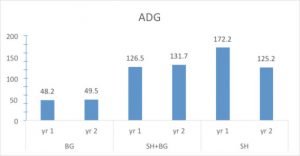
Figure 4. Average daily gain (ADG) of meat goats in multi-forage system in Tuskegee University in Alabama during 2 years.
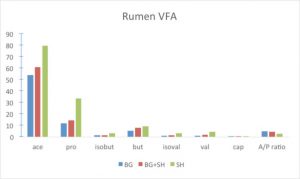
Figure 5. Rumen volatile fatty acids (VFA) production of meat goats in multi-forage system in Tuskegee University in Alabama during 2 years.
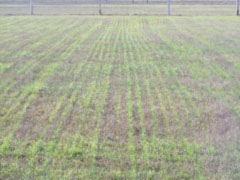
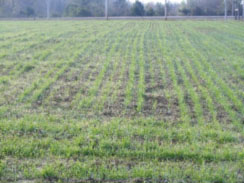
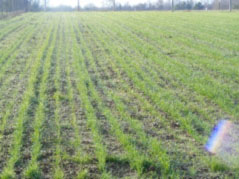
(a) BG followed by wheat (b) BG+SH followed by wheat (c) SH followed by wheat
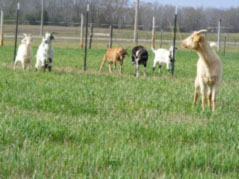
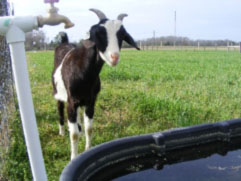
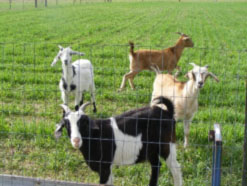
(d) (e) (f)
Figure 6. Winter wheat forage biomass production after planted by BG (a), BG+SH (b), and SH (c) and meat goats performance (d, e, and f, respectively) in multi-forage system in Tuskegee University in Alabama 2017.
Animal Health and Parasite Load
As an indication of animal health, fecal egg counts (FEC) and FEMACH for animals were measured during 2 years (Figure 7). Fecal egg count (b) in each year and average fecal egg counts (c) during 2 years for growing goats was higher (P < 0.05) for BG than for other legume forage combination, but FAMACHA number was higher for the SH than for the other treatments. These results indicated that legume forage combinations or legume forage alone could affect gastrointestinal parasites infection to growing goats during hot summer period. This is probably mainly due to the different forage height (BG vs. SH) and diet contains higher CP (25.7% CP DM) and rumen VFA content compared to BG (16.5 % CP DM) diet (Figures 3 and 5).
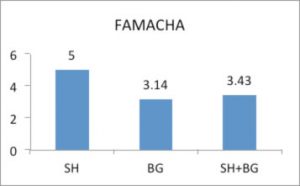
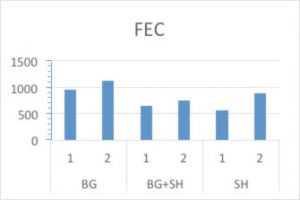
(a) (b)
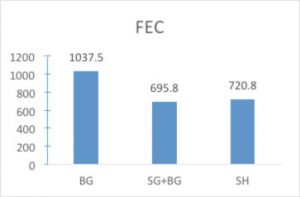
(c)
Figure 7. FAMACHA score (a), fecal egg count in each year (b) and average fecal egg count (FEC; c) during 2 years in multi-forage system.
Objective 3. To determine soil quality changes using multi-culture grasses, and grasses in combination with legume forages.
We know that soil changes as affected by sources of forages growing on the soil may be slow and need long term studies. Soil quality in SH forage was significantly higher (P < 0.01) for the Ca (ppm) than for the BG, but soil Mg and P contents were higher for BG than for SH forage (Figure 8). Soil N content was not significant between treatments (not shown in the text).
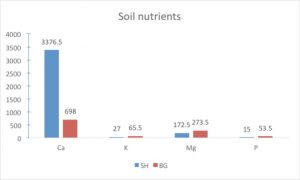
Figure 8. Soil nutrient composition in multi forages system in summer 2016.
Objective 4. To identify and assess economic characteristics and optimum economy.
Annual worm-season legumes or mixed with SH+BG forage production system may offer advantages over summer forage production followed by winter wheat crops for forage production. Our objective was to evaluate the effects of intercropping summer legume forage along with grass BG planting on forage yields, nutritive value, animal performance and economic returns. The increased fertilizer costs associated with the legume component of legume forage followed by winter wheat intercropping relative to sole BG forage or winter wheat forage with fertilizer application system can only be justified if legume forage or legume + grass forages intercrop yields are similar to or greater than sole BG forage, and nutritive value is improved.
In our study, mean economic returns for summer forages were $942.2 (-fertilizer) and 686.6/ha (+fertilizer) for SH and BG forage system, respectively. Total economic returns for summer forage were $1050 and 890/ha and mean seed cost were $107.85 and $94.37 for SH and BG, respectively. How was economic return calculated? Total seed costs are based on $3.08/kg for BG seed and $ 3.52/kg for SH seed. Total forage values are based on the alfalfa pellet pricing formula. Fertilizer (16-16-15) cost was $0.65/kg and spent $109/ha in year 2015. We feel using proper forages for summer legume grazing followed by winter forages without fertilization can provide for year-round foraging system with more marginal returns. However, combination of forages used for grazing should be selected to optimize animal performance, enhance the soil property and reduce methane or ammonia emission from feces while reducing dependency on petrochemical fertilizer. We are hoping that combining legume forages with grasses will increase protein output as well as restore N in soil, thus reducing dependency on petroleum-based fertilizer.
These major economic benefits were as follows:
- Warm-season legume SH forage can be used for alternative forage crops for year-round forage systems and provide high nutritive value of feed for animal and soil-N for crop production and reduce fertilizer costs (about $109/ha/year).
- Sunn hemp, is a tropical legume that can both produce a large amount of biomass, provide high nutritive value of forage, better animal performance, and fix large amounts of soil organic matter, thus providing two benefits from one cover crop.
- Sunn hemp + BG mixed forage also can be used as summer forage system,
- These results indicated that SH or SH+BG legume forage combinations could be more beneficial to growing goats and provide sufficient nutrients for goats to maintain optimum weight gain in grazing animals. For the soil quality, SH and SH+BG combination could be beneficial to soil improvement, but soil mineral contents were varied for only 2 years experiment.
- It appears that SH or SH+BG can fit well into sustainable goat production system in Alabama.
Objective 5. To evaluate adaptability (on an experiment station with goats) and demonstrate applicability (on two small farms) of an integrated year round forage system using commercial goats.
One of the greatest successes of the outreach activity in our team has been the infusion of new year-round forage system and knowledge into commercial goat production system through helping progressive forage improvement and practical approaches model (Figures, 9, 10, and 11). For this objective two producers Russell Bean (Barbour Co.; Figure 10) and Gerald Gooden (Lee Co.; Figure 11) had been identified and are currently working with our team. The year 2016 was particularly difficult year for goat producers (Figure 1 b, d) because of widespread drought, which affected pasture production for both producers. However, the year 2015 we have the great success to introduce our new knowledge and cooperative work with producers that make improve pasture production and animal performance (Figure 11 and Pasture Work handout, Tuskegee University).
Forage chemical composition
Summer forage chemical composition of multi-cultural forage system is presented in Tables 2 and Figure 9. There was a forage chemical composition x location interaction (P < 0.05) for CP and NDF (Figure 9). Average CP and TDN contents in SH and SH+BG were higher than sole BG pasture system, but lower in NDF content. Interestingly, SH and SH + BG combinations in TU farm continued to have greater CP content, but lower NDF content (Figure 9), due to time of planting. TU farm planted 1st week of May in each year (a lot of rain), but producer farms planted seed on late Jun in each year which is becoming dry seasons in Alabama. The data indicated that soil nutrients and time of planting date are important factors affecting forage quality and forage DM production.
Table 2. Average forage chemical composition (% DM) in multi forages system in different locations in AL during 2 years (2015 and 2016).
_____________________________________________________________________________
Item TU farm Gooden Farm1 Russell Farm2
SH SH+BG BG SH SH+BG BG SH SH+BG BG
_____________________________________________________________________________
CP 25.7 28.5 16.5 17.9 16.3 8.5 14.4 12.6 7.6
ADF 47.2 48.6 41.6 54.0 46.1 43.3 54.1 46.1 43.3
NDF 42.5 39.9 46.2 58.9 60.9 77.2 66.1 70.1 72.2
TDN 62 63 61 58 57 53 55.5 54.5 54
___________________________________________________________________________________________
1Gooden farm located at Opelika, Lee County, AL; 2Russell Farm located at Eufaula, AL
CP=crude protein; ADF = acid detergent fiber, NDF = neutral detergent fiber, TDN = Total digestible nutrient.
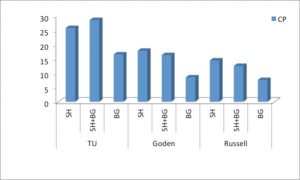
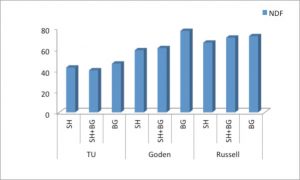
Figure 9. Average forage crude protein (CP; a) and fiber (neutral detergent fiber; b) compositions in multi-forage system in different locations in Alabama during 2 years. TU= Tuskegee goat farm in Tuskegee, AL, Gonden = Mr. Goden farm in Opelika, AL, Russell = Mr. Rusell farm in Eufala, AL.
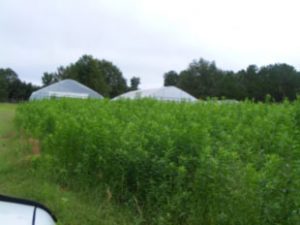
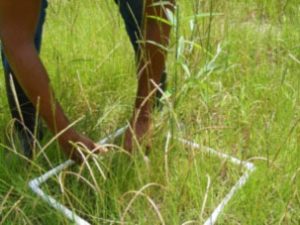
Sunn hemp forage Bermudagrass forage as a control
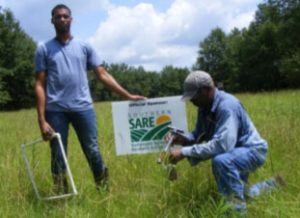
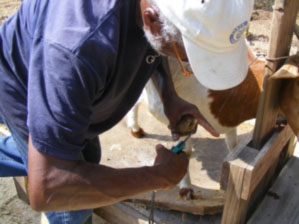
Soil sampling Foot trim with goats
Figure 10. Outreach activities in Russell Bean Farm (Barbour Co.)

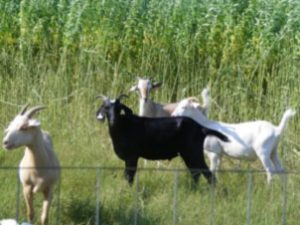
Sunn hemp forage Sunn hemp forage with goats
Figure 11. Outreach activities in G. Gooden farm (Lee Co., AL)
III. Impacts and Contributions/Outcomes
We feel using proper legume forages for summer grazing followed by winter forages can provide for year-round foraging system without minimum input of fertilizer. However, combination of forages used for grazing should be selected to optimize animal performance, enhance the soil property and reduce environmental pollution from feces while reducing dependency on petrochemical fertilizer. We are hoping that combining legume forages with grasses will increase protein output as well as restore 25-30% more N and organic matter in soil, thus reducing dependency on petroleum-based fertilizer. Publications from S-SARE project are shown below:
- Sustainable Year-Round Forage System for Goat Production in Southern USA. 2014. B.R. Min, S. Solaiman, N. Gurung, W. McElhenny. J. Animal Science. 105. E-suppl.2.
- Forage work for producers. 2017. B. R. Min, N. Gurung, and A. Elliott. Potential for Using New Sunn Hemp (Crotalaria junces L.) as Forages for Meat Goats in Alabama. June 21, 2017 (presented at the Alabama Commodity Conference, Birmingham, AL).
IV. Summary
- Pasture feeding is safe and relatively low cost.
- Warm-season legume forages followed by cool season forages can be used for alternative forage crops for year-round forage systems and provide high nutritive value of feed for animal and soil-N for crop production and reduce fertilizer costs.
- Summer forages such as SH and SH+BG mixed forages that can both produces a large amount of biomass, provide high nutritive value of forage, and fix 25-30% more soil nitrogen and organic matter, thus providing two benefits from one cover crop and help reduce N fertilizer. The results indicated that animals on SH or SH+BG combination grew 62 to 67% faster and reached expected slaughter weight in less time when compared to conventional BG pasture systems.
- It appears that legumes forages in warm season forage followed by winter wheat forage can fit well into sustainable goat production system in Alabama.
Educational & Outreach Activities
Participation Summary:
Extension and Outreach Program.
Pasture walk
A one-day pasture walk program was organized with several producers in attendance (Figure 12). The program began with a pasture walk followed by questions/answers session. Much of the interest was focused on sunn hemp forage. Producers were also requesting us to carry out further studies with sunn hemp that can produce seeds and forage regrowth. The final goat production performance based on these forages will be disseminated to a larger audience and other stake holders through fact sheets, popular articles and to scientific community through referred journal articles.
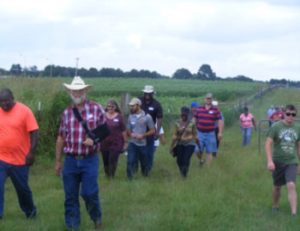
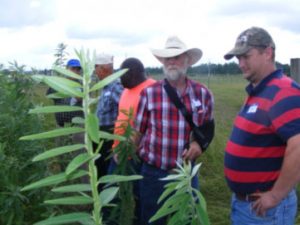
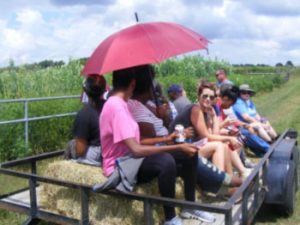

Figure 12. Pasture walk and hay rides with producers, 2017.
Hay production demonstration and hay rides
The benefit of hay making before or after grazing is to extend the sustainability of the system in terms of animal feeding and production. Our results indicated that dry matter production as hay was higher for SH (16 squire bales/ac) and SH+BG (14 bales/ ac) when compared to sole BG hay (12 bales/ac.).
Impacts and Contributions/Outcomes
We feel using proper legume forages for summer grazing followed by winter forages can provide for year-round foraging system without minimum input of fertilizer. However, combination of forages used for grazing should be selected to optimize animal performance, enhance the soil property and reduce environmental pollution from feces while reducing dependency on petrochemical fertilizer. We are hoping that combining legume forages with grasses will increase protein output as well as restore 25-30% more N and organic matter in soil, thus reducing dependency on petroleum-based fertilizer. Publications from S-SARE project are shown below:
- Sustainable Year-Round Forage System for Goat Production in Southern USA. 2014. B.R. Min, S. Solaiman, N. Gurung, W. McElhenny. J. Animal Science. 105. E-suppl.2.
- Forage work for producers. 2017. B. R. Min, N. Gurung, and A. Elliott. Potential for Using New Sunn Hemp (Crotalaria junces L.) as Forages for Meat Goats in Alabama. June 21, 2017 (presented at the Alabama Commodity Conference, Birmingham, AL).
Learning Outcomes
Project Outcomes
Impacts
We feel using proper legume forages such as SH for summer grazing followed by winter forages (e.g. winter wheat) can provide for year-round foraging. However, combinations of forages used for grazing should be selected to optimize animal performance, enhance soil properties and reduce methane or ammonia emission from feces while reducing dependency on petrochemical fertilizer. We are hoping that combining legume forages with grass cropping systems will increase protein output as well as restore N in the soil, thus reducing dependency on petroleum-based fertilizer.
Accomplishments
Please see attached file.